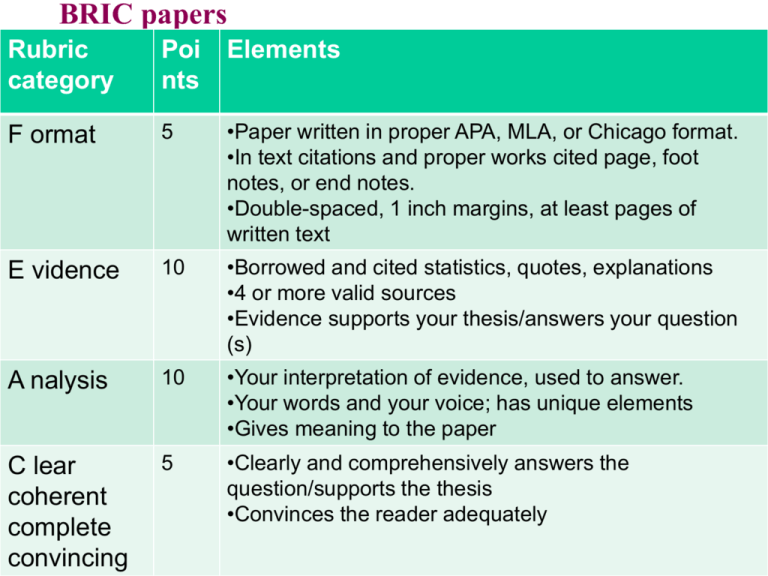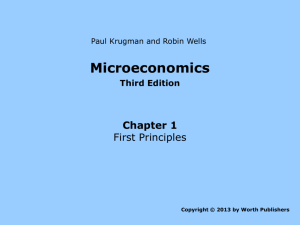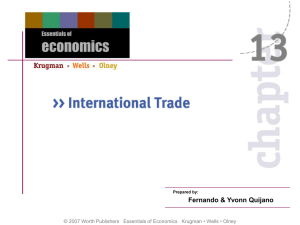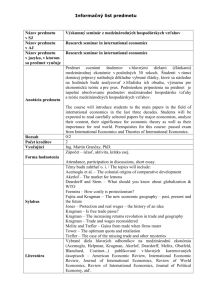Essentials of Economics, Krugman Wells Olney
advertisement

BRIC papers Poi nts Elements F ormat 5 •Paper written in proper APA, MLA, or Chicago format. •In text citations and proper works cited page, foot notes, or end notes. •Double-spaced, 1 inch margins, at least pages of written text E vidence 10 •Borrowed and cited statistics, quotes, explanations •4 or more valid sources •Evidence supports your thesis/answers your question (s) A nalysis 10 •Your interpretation of evidence, used to answer. •Your words and your voice; has unique elements •Gives meaning to the paper C lear coherent complete convincing 5 •Clearly and comprehensively answers the question/supports the thesis •Convinces the reader adequately chapter Rubric category © 2007 Worth Publishers Essentials of Economics Krugman • Wells • Olney What is it and how does it relate to: a) Our 3rd quarter projects? b) Your spring breaks? Prepared by: Fernando & Yvonn Quijano © 2007 Worth Publishers Essentials of Economics Krugman • Wells • Olney chapter What you will learn in this chapter: ➤ An overview of macroeconomics, the study of the economy as a whole, and how it differs from microeconomics ➤ The importance of the business cycle and why policy makers seek to diminish the severity of business cycles ➤ The meaning of inflation and deflation and why price stability is preferred Even the best students had a tough time finding a job in 2002. © 2007 Worth Publishers Essentials of Economics Krugman • Wells • Olney 3 of 22 chapter How would a macroeconomist view the business cycle and what might (s)he want to do about it? © 2007 Worth Publishers Essentials of Economics Krugman • Wells • Olney 4 of 22 chapter TABLE 14-1 Median Starting Salaries of New MBAs from Selected Schools in 2000, 2002, and 2004 School 2000 starting salary 2002 starting salary 2004 starting salary Stanford $165,500 $138,100 $150,000 Harvard 160,000 134,600 147,500 Pennsylvania 156,000 124,500 144,000 Columbia 142,500 123,600 142,500 Dartmouth 149,500 122,100 135,000 What do you see here? Why did it occur? © 2007 Worth Publishers Essentials of Economics Krugman • Wells • Olney 5 of 22 chapter Microeconomics versus Macroeconomics TABLE 14-2 Microeconomic versus Macroeconomic Questions Microeconomic Questions Macroeconomic Questions Should I go to business school or take a job right now? How many people are employed in the economy as a whole this year? What determines the salary offered by Citibank to Cherie Camajo, a new Columbia MBA? What determines the overall salary levels paid to workers in a given year? What determines the cost to a university or college of offering a new course? What determines the overall level of prices in the economy as a whole? What government policies should be adopted to make it easier for low-income students to attend college? What government policies should be adopted to promote employment in the economy as a whole? © 2007 Worth Publishers Essentials of Economics Krugman • Wells • Olney 6 of 22 chapter © 2007 Worth Publishers Essentials of Economics Krugman • Wells • Olney 7 of 22 chapter Microeconomics versus Macroeconomics Economic Aggregates Economic aggregates are economic measures that summarize data across different markets for goods, services, workers, and assets. © 2007 Worth Publishers Essentials of Economics Krugman • Wells • Olney 8 of 22 chapter Microeconomics versus Macroeconomics Macroeconomics: The Whole Is Greater Than the Sum of Its Parts A key insight into macroeconomics is that in the short run—a time period consisting of several years but typically less than a decade—the combined effect of individual decisions can have effects that are very different from what any one individual intended, effects that are sometimes perverse. i.e. - Rubber necking And The “paradox of thrift” and vice versa The behavior of the macroeconomy is, indeed, greater than the sum of individual actions and market outcomes. © 2007 Worth Publishers Essentials of Economics Krugman • Wells • Olney 9 of 22 chapter p. 366 #2 © 2007 Worth Publishers Essentials of Economics Krugman • Wells • Olney 10 of 22 chapter Microeconomics versus Macroeconomics Macroeconomic Policy The area of microeconomics, in general, suggests a limited role for government intervention. In contrast, economists generally believe there is a much wider role for government to play in macroeconomics—most importantly, to manage short-term fluctuations and adverse events in the economy. Entonces, in which decade was American macroeconomic policy really born? © 2007 Worth Publishers Essentials of Economics Krugman • Wells • Olney 11 of 22 chapter p. 366 #3 economics in action The Great Depression © 2007 Worth Publishers Essentials of Economics Krugman • Wells • Olney 12 of 22 chapter How did the Great Depression of the 1930’s affect macroeconomic policy in 2008? © 2007 Worth Publishers Essentials of Economics Krugman • Wells • Olney chapter Who is John Maynard Keynes and what influence did he have in the development of modern macroeconomic theory? © 2007 Worth Publishers Essentials of Economics Krugman • Wells • Olney 14 of 22 chapter John Maynard Keynes, 1st Baron Keynes (5 June 1883 – 21 April 1946), was a British economist whose ideas have profoundly affected the theory and practice of modern macroeconomics, as well as the economic policies of governments. He greatly refined earlier work on the causes of business cycles, and advocated the use of fiscal and monetary measures to mitigate the adverse effects of economic recessions and depressions. His ideas are the basis for the school of thought known as Keynesian economics, as well as its various offshoots. In the 1930s, Keynes spearheaded a revolution in economic thinking, overturning the older ideas of neoclassical economics that held that free markets would in the short to medium term automatically provide full employment, as long as workers were flexible in their wage demands. Keynes instead argued that aggregate demand determined the overall level of economic activity, and that inadequate aggregate demand could lead to prolonged periods of high unemployment. Following the outbreak of World War II, Keynes's ideas concerning economic policy were adopted by leading Western economies. During the 1950s and 1960s, the success of Keynesian economics resulted in almost all capitalist governments adopting its policy recommendations, promoting the cause of social liberalism. © 2007 Worth Publishers Essentials of Economics Krugman • Wells • Olney 15 of 22 chapter The Business Cycle © 2007 Worth Publishers Essentials of Economics Krugman • Wells • Olney 16 of 22 chapter © 2007 Worth Publishers Essentials of Economics Krugman • Wells • Olney 17 of 22 chapter © 2007 Worth Publishers Essentials of Economics Krugman • Wells • Olney 18 of 22 chapter What do you think were the opinions and effects of the: American Recovery and Reinvestment Act? Troubled Asset Relief Program? © 2007 Worth Publishers Essentials of Economics Krugman • Wells • Olney 19 of 22 chapter The Business Cycle The business cycle is the short-run alternation between economic downturns, known as recessions, and economic upturns, known as expansions. A depression is a very deep and prolonged downturn. Recessions are periods of economic downturns when output and employment are falling. Expansions, or recoveries, are periods of economic upturns when output and employment are rising. © 2007 Worth Publishers Essentials of Economics Krugman • Wells • Olney 20 of 22 chapter © 2007 Worth Publishers Essentials of Economics Krugman • Wells • Olney 21 of 22 chapter The Business Cycle Employment and Unemployment Employment is the number of people currently employed in the economy. Unemployment is the number of people who are actively looking for work but aren’t currently employed. The labor force is equal to the sum of employment and unemployment. Discouraged workers are nonworking people who are capable of working but have given up looking for a job. © 2007 Worth Publishers Essentials of Economics Krugman • Wells • Olney 22 of 22 chapter p. 362 #1,2,3 © 2007 Worth Publishers Essentials of Economics Krugman • Wells • Olney 23 of 22 chapter © 2007 Worth Publishers Essentials of Economics Krugman • Wells • Olney 24 of 22 chapter The Business Cycle Employment and Unemployment Underemployment is the number of people who work during a recession but receive lower wages than they would during an expansion due to fewer number of hours worked, lower-paying jobs, or both. The unemployment rate is the percentage of the total number of people in the labor force who are unemployed. (14-1) Unemployment rate = Number of unemployed workers x 100 Number of unemployed workers Number of employed workers © 2007 Worth Publishers Essentials of Economics Krugman • Wells • Olney 25 of 22 chapter Unemployment mathematics 1. P. 366 #4 2. Number of people employed: 120,500 Number of people unemployed: 4,050 How many total people are in the workforce? What is the unemployment rate? © 2007 Worth Publishers Essentials of Economics Krugman • Wells • Olney 26 of 22 chapter The Business Cycle Aggregate Output Aggregate output is the economy’s total production of final goods and services for a given time period. © 2007 Worth Publishers Essentials of Economics Krugman • Wells • Olney 27 of 22 chapter The Business Cycle Aggregate Output © 2007 Worth Publishers Essentials of Economics Krugman • Wells • Olney 28 of 22 chapter Thursday 3/24/2011 1. Lecture ch 14 Macroeconomics 2. Look at Homework: p. 364 #1 and page 366 #5 HW – Be sure all problems are complete. Tomorrow – Finish up and Review Monday – Ch 14 Quiz © 2007 Worth Publishers Essentials of Economics Krugman • Wells • Olney 29 of 22 chapter What tools can policy makers use to affect the state of the business cycle? © 2007 Worth Publishers Essentials of Economics Krugman • Wells • Olney 30 of 22 chapter The Business Cycle Taming the Business Cycle Policy efforts undertaken to reduce the severity of recessions and to rein in excessively strong expansions are called stabilization policy. Monetary policy is a type of stabilization policy that involves changes in the quantity of money in circulation or in interest rates, or both. Fiscal policy is a type of stabilization policy that involves changes in taxation or in government spending, or both. © 2007 Worth Publishers Essentials of Economics Krugman • Wells • Olney 31 of 22 chapter economics in action Has the Business Cycle Been Tamed? © 2007 Worth Publishers Essentials of Economics Krugman • Wells • Olney 32 of 22 chapter What’s misleading about this statement? 'Country A is becoming wealthier each year than Country B because its wage levels are rising by an average of $500 compared to $250 in Country B'. © 2007 Worth Publishers Essentials of Economics Krugman • Wells • Olney 33 of 22 chapter Inflation and Deflation A nominal measure is a measure that has not been adjusted for changes in prices over time. A real measure is a measure that has been adjusted for changes in prices over time. © 2007 Worth Publishers Essentials of Economics Krugman • Wells • Olney 34 of 22 chapter Inflation and Deflation The aggregate price level is the overall price level for final goods and services in the economy. A rising aggregate price level is inflation. A falling aggregate price level is deflation. Inflation reduces the real value of money over time; conversely, deflation increases the real value of money Which one would encourage consumption? Which one would encourage saving? What can go wrong when everyone starts saving? © 2007 Worth Publishers Essentials of Economics Krugman • Wells • Olney 35 of 22 chapter Inflation and Deflation The CPI • A consumer price index (CPI) measures changes in the price level of consumer goods and service purchased by households. • The CPI is defined by the United States Bureau of Labor Statistics as "a measure of the average change over time in the prices paid by urban consumers for a market basket of consumer goods and services." • The CPI is a statistical estimate constructed using the prices of a sample of representative items whose prices are collected periodically. The annual percentage change in a CPI is used as a measure of inflation. • A CPI can be used to index (i.e., adjust for the effect of inflation) the real value of wages and salaries • In most countries, the CPI is, along with the population census and the USA National Income and Product Accounts, one of the most closely watched national economic statistics. © 2007 Worth Publishers Essentials of Economics Krugman • Wells • Olney 36 of 22 chapter © 2007 Worth Publishers Essentials of Economics Krugman • Wells • Olney 37 of 22 chapter Inflation and Deflation The economy has price stability when the aggregate price level is changing only slowly. The inflation rate is the annual percent change in the aggregate price level. © 2007 Worth Publishers Essentials of Economics Krugman • Wells • Olney 38 of 22 chapter Inflation and Deflation © 2007 Worth Publishers Essentials of Economics Krugman • Wells • Olney 39 of 22 chapter © 2007 Worth Publishers Essentials of Economics Krugman • Wells • Olney chapter Economics in Action Let’s read “A Fast Food measure of Inflation” on p. 364 P. 366 #5 © 2007 Worth Publishers Essentials of Economics Krugman • Wells • Olney 41 of 22 chapter KEY TERMS Economic aggregates Business cycle Depression Recessions Expansions Employment Unemployment Labor force Discouraged workers Underemployment Unemployment rate Aggregate output Stabilization policy Monetary policy Fiscal policy Nominal Real Aggregate price level Inflation Deflation Price stability Inflation rate © 2007 Worth Publishers Essentials of Economics Krugman • Wells • Olney 42 of 22







